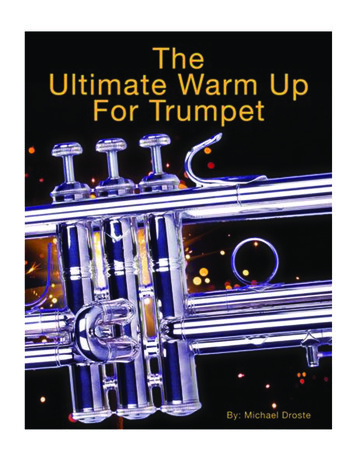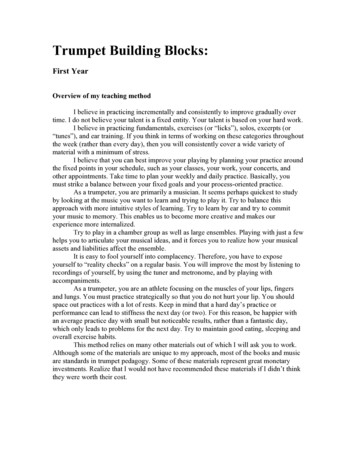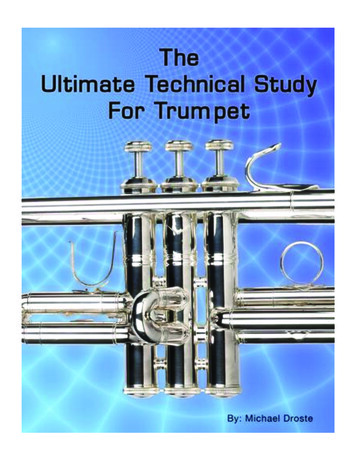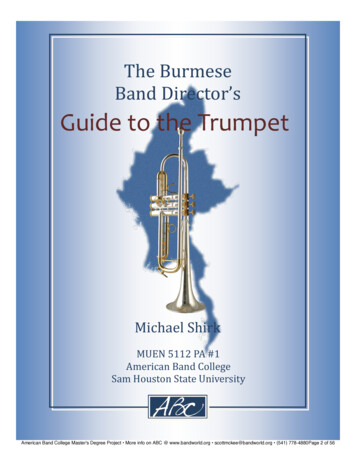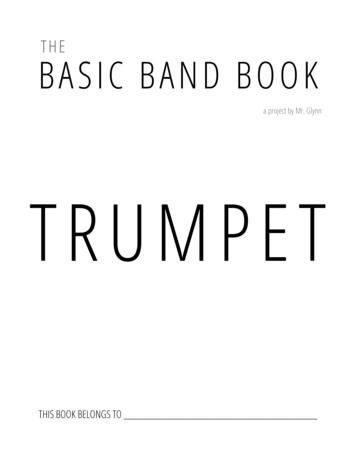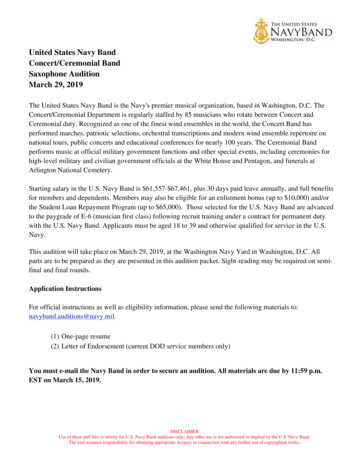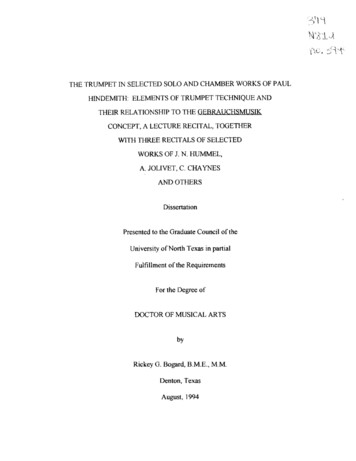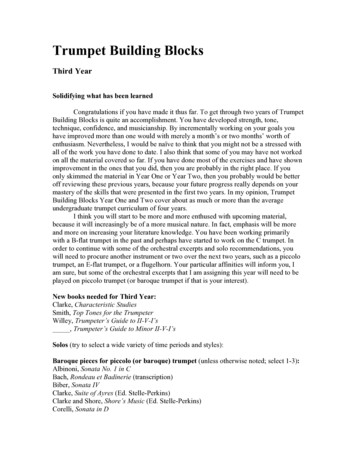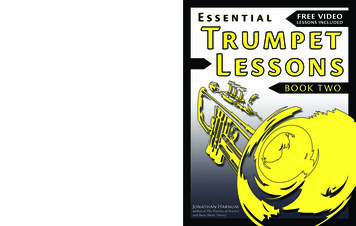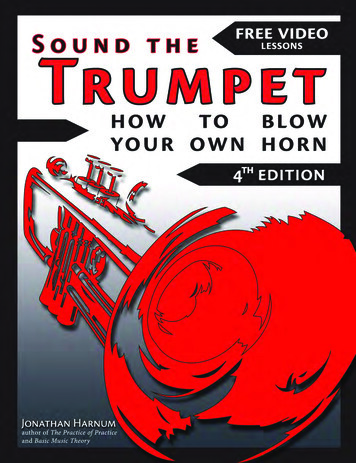
Transcription
Pirate BandPublicationsBb Trumpet / CornetBrass Tone BoostersA Guide to a StrongerBrass EmbouchureTopics IncludePosture & BreathingLong TonesPedal TonesLip SlursRange
A M E R I C A NS A MH O U S T O NB A N DO FS T A T EC O L L E G EU N I V E R S I T YBb Trumpet / CornetBrass Tone BoostersA guide to a StrongerBrass Embouchureby Daniel PaulsenPirate BandPublicationsAmerican Band College at Sam Houston State UniversityMUEN 5398 Ensemble Project Practical Application #2
Fo rw a rdDear Student,!I am so excited that you have decided to join the Reedley High School band! Thisbooklet was written for you, the trumpet players in our program, and we will be using itevery brass rehearsal this fall during the marching band season. By implementing thisbooklet, we hope to help you learn to play with a mature, powerful trumpet sound. Butfair warning: there are no magic bullets or short cuts! These exercises are great tools, andwith daily repetition you will improve in several aspects of your playing: your tone,flexibility, range, endurance, and overall power! This booklet includes great remindersfor what you may already know, and some effective new techniques that might be new toyou!!Please remember when learning the techniques that these type of warm-upexercises have been around since these instruments were first made, so do not think thatthey are the only exercises that work for brass players. They are just a few examples of thelimitless possibilities to play. What is most important are the key ideas behind theexercises and the purposeful application while playing. Take these examples and trythem, find out which ones work best for you, and modify them and make them your own.Good luck and enjoy playing the trumpet!Sincerely,Daniel PaulsenReedley High School Band DirectorHigh/Low Brass Instructor
Introduction!4What is an Embouchure?!4What is a Warm-up?!4Ta r g e t E m b o u c h u r e E l e m e n t s!5Sound:!5Flexibility:!5Range:!5Endurance:!5B r e a t h i n g a n d P o s t u r e!7Breathing Technique!7Breathing Exercises!7Posture!9Hand Position!What the Buzz is About !1011Terms to Know!11Making the Buzz!11Good Embouchures!12Poor Embouchure Examples!13LONG TONES!15Mouth p i ece Bu z z i n g!17!Buzzing the Lead-Pipe !17Buzzing During Practices!17
What is a Lip Slur?!Low Tone Exercises!PEDAL TONES!R a n g e!Range Check-List!Endur an ce!202424272731How to Build Muscle Strength!31Projection!33Wa r m i n g D o w n!34Tr o u b l e S h o o t i n g!37Simple Solutions to Tone Problems!Mouth p i ece S el ect io n!3839Mouthpiece Anatomy!39Mouthpiece Choices!40Sugge st ed M at eri a ls!42Tumpet Method Books!42Trumpet Study Books!42B i b l i o g r a p h y!45
In troductionWhat is an Embouchure?An embouchure is something all wind instrument musicians have, whether they know itor not! It is all the physical parts of our face that go into blowing air into our instruments,including our lips, tongue, oral cavity, chin, teeth, etc. All trumpet players use it everytime they play, and every single embouchure is unique.Even though there are no two embouchures alike, proficient trumpet players havecommon characteristics that give them a mature sound. Some people have a naturalgreat sound the first time they pick up the instrument, but the rest of us have to developa great tone on our instrument. So how does an intermediate trumpet player get thatbeautiful sound?The answer is more than just random playing your trumpet, though this will more likelyhelp than not playing at all. The key is to develop your embouchure, just like an athleteworks to make his or her body stronger, faster, or quicker. We can train ourembouchure with specific exercises to target improvements in flexibility, range,endurance, and our overall tone or sound. Each musician has different strengths andareas for improvement, and these exercises can be tailored to the individual formaximum benefits. But what would this look like?What is a Warm-up?The best time to work on improving your own playing is through a routine every time youpull out the instrument. A warm-up is a routine that musicians go through to get ready toplay their best. It is a time to get mentally and physically prepared, as well as a time toimprove or develop your own playing. The possible parts of a warm-up are endless andeach player has his or her own special way of doing one that fits best for him or herself.However there are common techniques that are unique to brass players which seem tobring the best results in a warm-up, for example long tones, lip slurs, tonguingexercises, etc. Each is a way to prepare and develop different parts of the playingprocess, such as the lips, the lungs, the tongue, the fingers, the ears, and mostimportantly the mind.In this booklet you will find several examples of common parts of a brass warm-up thattarget different ways to improve your embouchure. By using this booklet you will learnmore about how to build your embouchure for a better trumpet sound, but also whywarming-up is important. You will learn some of the tricks of the trade for improvingyour playing every time you pull out the instrument.What this booklet is not is the end-all of trumpet books or the answer to all your playingproblems. It is a start for those players who are seeking to improve their sound and getserious about playing the trumpet. The exercises are just a sample of the infinitepossibilities that can be played while warming-up, and at the back of the book there is alist of great materials for further study.4
T a r get E m b o u c h u r eEl em en tsAccording to David Bilger, trumpet player for the Philadelphia Orchestra, trumpettechnique can be broken down into 6 main areas: Sound (tone production), Flexibility,Endurance, Range, Articulation and Agility. In this booklet we will focus on the firstfour elements. Good tone production on the trumpet is a combination of a functionalembouchure and the proper use of air. Therefore, this booklet will focus on improvingboth. We will do this by using the various elements of a warm-up:Sound: Breathing Exercises: As wind players we need to use our “fuel” efficiently and withouttension. This can enable us to play longer, higher, lower, softer, with more power, etc. Long Tones: Playing sustained notes for longer durations, making sure that the tone isfull and that the pitch is stable. Pedal tones and lip bends: Using both pedal tones and lip bends can strengthen theembouchure. Mouthpiece buzzing: Any playing that can be done on the trumpet can be done on themouthpiece alone. Mouthpiece buzzing is an important part of sound developmentbecause if forces the player to focus the notes instead of relying on the trumpet to do itfor you.Flexibility:Flexibility imparts all aspects of trumpet playing, especially endurance and range. Thisis the ability to change notes and intervals fluidly, quickly, and with good tone. The goalis to be able to move in all registers, low or high, with ease and control.Range:Range (both high and low) is a product of embouchure strength, tongue position, airflow, and efficiency. Many exercises that we have already discussed will increaserange, such as pedal tones, lip bends, flexibility studies, etc. Most people onlyconcentrate on playing higher in their range, but the key is actually learning to playlower as well! Remember, if you donʼt practice it, you canʼt do it! This applies to highand low notes.Endurance:As is the case with range, endurance is also a combination of many of the topics wehave already touched on, and will benefit from many of the same exercises. The twoother things that will most quickly improve endurance are strength training and avoidingbad habits that can actually make your playing more difficult.5!
Strength development is another aspect of playing that comes from many differentsettings, but can be targeted for fast improvement. Loud practice is one way to developstrength, and sustained playing is another. These will not only train your embouchuremuscles but also your abdominal muscles too. To counter playing at loud volumes besure to practice some amount of time on soft playing during your sessions.Avoiding bad habits can be described as efficiency, and is necessary for any brassplayer. Playing the trumpet is extremely physical, and efficient playing will reduce thedemands on the player. Efficiency can be achieved by taking care of the following:1) A good use of air support in all aspects of playing.2) Eliminating lip pressure while playing (as much as possible).3) Knowing your playing limits and not damaging your embouchure.6
Breath in g an d PostureNothing is more important than starting off correctly! Posture, breathing, and handposition should be taught and practiced correctly from the beginning. “Practice makespermanent!” Whatever we do in the rehearsal room or at home will be what we do inperformances.Breathing TechniqueStarting each session with breathing exercises is imperative! We are wind players, andwe must learn to use our “fuel” correctly for a more powerful sound. The student should sit or stand with his or her body in balance and without tensionwhen playing or for breathing exercises. This can be found by: Stand up or sit up tall and find your center of balance where you are neither leaningforward or backward but relaxed. Your body without tension is the most efficientposture for breathing! Wind players should be striving for an “Oh” shape on inhalation and exhalation. Aninvigorated yawn is another way to gain a correct breath. There should be no tensionin the lips, throat, or lungs: if it hurts, donʼt do it! The lungs will expand in all directions when you breathe. Not up into your shoulders,or down into your belly. It will feel like your front and back ribs will expand from thecenter of your body. Try putting your hands flat on your back ribs: are theyexpanding? Breathing should be done in time with the music. Make sure that the breath is exhaledimmediately after inhalation (no hesitation).Breathing ExercisesPatrick Sheridan and Sam Pilafian, two amazing tuba players, invented some greatbreathing exercises for wind players in their book, The Breathing Gym. We will usesome of their exercises for our warm-ups to develop fuller, deeper, and more relaxedbreathing habits.Below are some examples of breathing exercises thatshould be used each day. These are done atapproximately 60 beats per minute. Use these handpositions to help you monitor the right air flow as youdo the exercises:Flat hand sideways in front of your mouth breathing IN Open “Oh” shape, hand placement causing a rushingair sound.7
BREATHING/POSTUREHand flat in front of your mouth 12” awaybreathing OUT Blow the air against your hand about 12”away. Breathing OUT will feel like blowing cold airwith an “Oh” shape with the mouth.There should be no space or pause betweenbreathing in and out: keep the air flowing!Breathing Exercise #14 beats in, 4 beats out (repeat)3 beats in, 3 beats out (repeat)2 beats in, 2 beats out (repeat)1 beat in, 1 beat out (repeat)1 beat in, 1 beat out (repeat)2 beats in, 2 beats out (repeat)3 beats in, 3 beats out (repeat)4 beats in, 4 beats out (repeat)Breathing Exercise #24 beats in, 4 beats out (steady air on exhalation or slight crescendo)4 beats in, 8 beats out (steady air on exhalation or slight crescendo)4 beats in, 12 beats out (steady air on exhalation or slight crescendo)""Rest 15 sec2 beats in, 4 beats out (steady air on exhalation or slight crescendo)2 beats in, 8 beats out (steady air on exhalation or slight crescendo)2 beats in, 12 beats out (steady air on exhalation or slight crescendo)""Rest 15 sec1 beat in, 4 beats out (steady air on exhalation or slight crescendo)1 beat in, 8 beats out (steady air on exhalation or slight crescendo)1 beat in, 12 beats out (steady air on exhalation or slight crescendo)Breathing Exercise #34 beats in, 4 beats hold, 2 beats out loud, 1 beat hold, 2 beats out loud, hiss until empty"Repeat 3 times, each time breathing in deeper than before.Breathing Exercise #416 beats in slowly & evenly, hold 4 beats, then blow out as fast as possible (open “Oh”)"Repeat 3-4 times8
BREATHING/POSTUREPostureGood posture while seated: the trumpet playerʼs feetare flat against the floor and his back is straight. He isnot leaning against the chair, even though he is seatedtowards the back (If you are taller, you might need tofind a taller chair or you may need to sit more to thefront of the chair and your feet more underneath tohave proper balance). Notice that the shoulders arerelaxed and the neck is not bent. Always keep the headup and looking straight forward, then bring the horn toyour face. Some players will need to hold the trumpetat a lower angle because of their dental structure.Arnold Jacobs, the great tuba player and masterteacher, has good advice about the seated posture. Headvises that you should sit in a way that you can standup immediately. This sounds simple but will probablytake some adjustment before you are able to do it. Try it, and if you have to leanforward before you stand, you do not have it quite right yet. Keep your back off thechair and sit on the front half of the chair.C. Too Ridged at AttentionGood posture while standing: the trumpetplayerʼs upper body looks identical to hisposture while seated; he does not need to leanback, or forward, or tense his neck muscles.Your feet should be slightly less thanshoulderʼs width apart. Practicing whilestanding up is naturally helpful to healthy airsupport, as it eliminates the tendency toslouch.9!
BREATHING/POSTUREHand PositionGood hand position, option 1: In these pictures (above), the left hand supports theweight of the trumpet with the index finger. The ring finger is available to extend the thirdvalve slide, and the thumb operates the first valve slide. Players with small hands maychoose to place both the ring finger and the pinky in the third-slide ring so as to facilitatetriggering, or in some
Tumpet Method Books! 42 Trumpet Study Books! 42 Bibliography! 45. Introduction What is an Embouchure? An embouchure is something all wind instrument musicians have, whether they know it or not! It is all the physical parts of our face that go into blowing air into our instruments, including our lips, tongue, oral cavity, chin, teeth, etc. All trumpet players use it every time they play, and .
